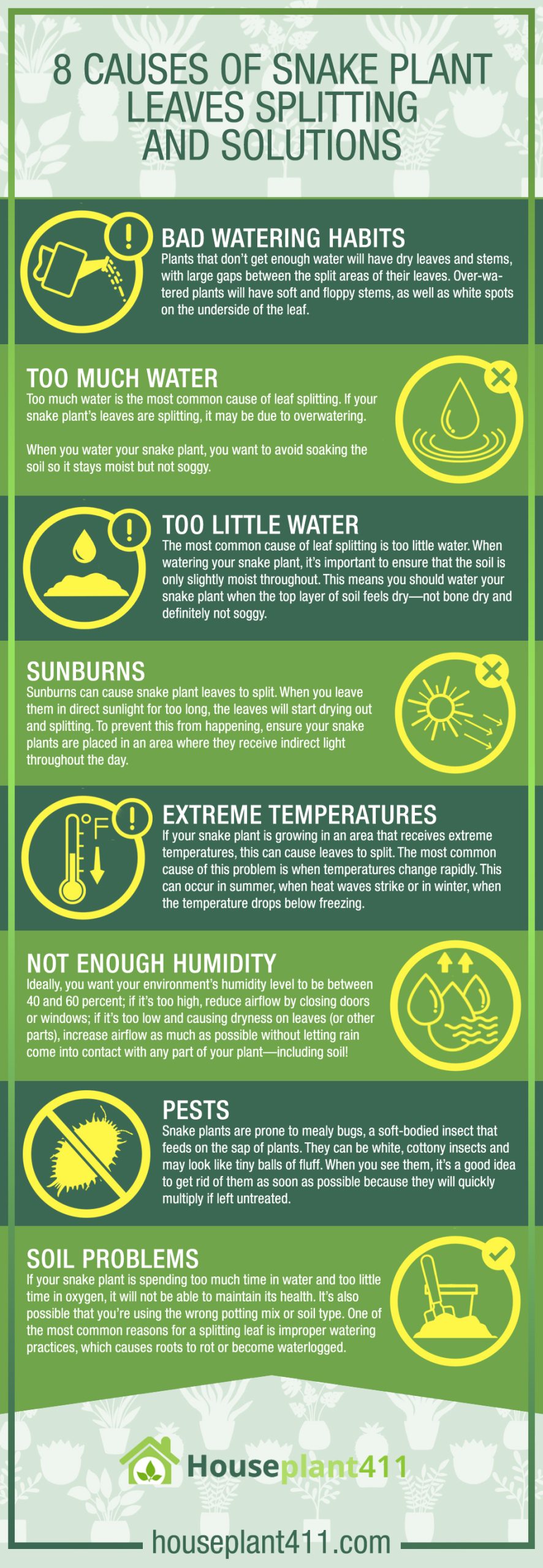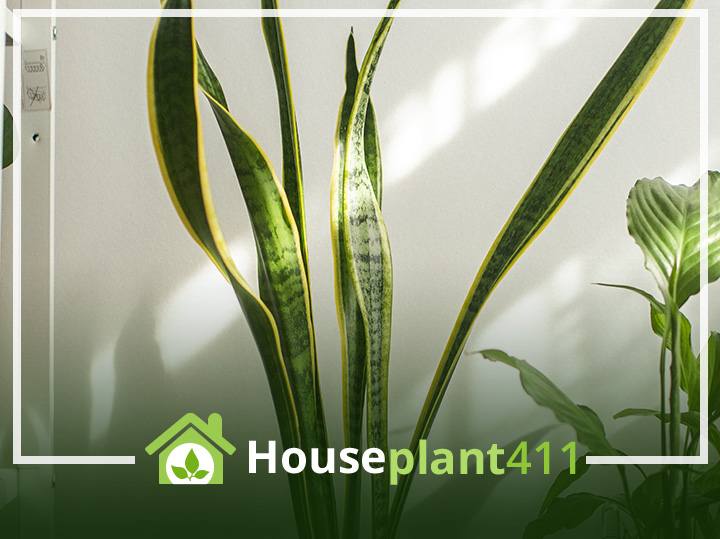Snake plants are a great addition to any home. However, if you’ve got one and you notice that the leaves of your snake plant are splitting, don’t worry! There are several things that could be causing this problem, and we’ll list them below. After identifying how your snake plant’s leaves are splitting (and hopefully preventing them from doing so in the future), you’ll be able to keep your favorite houseplant healthy for years.
Bad Watering Habits
Bad watering habits can cause splitting leaves. Symptoms include plants that don’t get enough water or plants that are over-watered.
Plants that don’t get enough water will have dry leaves and stems, with large gaps between the split areas of their leaves. Over-watered plants will have soft and floppy stems, as well as white spots on the underside of the leaf.
Too Much Water
Too much water is the most common cause of leaf splitting. If your snake plant’s leaves are splitting, it may be due to overwatering.
When you water your snake plant, you want to avoid soaking the soil so it stays moist but not soggy.
If you water too often or too much, then the soil can become too damp and will not absorb moisture as easily when watered again. This can lead to root rot in your snake plant if left untreated.
Too Little Water
The most common cause of leaf splitting is too little water. When watering your snake plant, it’s important to ensure that the soil is only slightly moist throughout. This means you should water your snake plant when the top layer of soil feels dry—not bone dry and definitely not soggy. If you overwater your snake plant, it will cause its leaves to split at the tips as well as along their length.
Sunburns
Sunburns can cause snake plant leaves to split. When you leave them in direct sunlight for too long, the leaves will start drying out and splitting. To prevent this from happening, ensure your snake plants are placed in an area where they receive indirect light throughout the day. If you’re using artificial lights, keep them about 2 feet away from your snake plants since UVB rays can reach them only when there is a distance of 4-5 inches between your lights and their leaves.
If you have already experienced sunburns on your snake plant leaves, don’t worry; it isn’t permanent as long as you handle it correctly! You just need to give each affected leaf a good soak in water with some fertilizer added before placing it back into its pot or container (this is especially true if the sunburn happened due to neglect). This should help revive those damaged areas so they can grow back again!
Extreme Temperatures
If your snake plant is growing in an area that receives extreme temperatures, this can cause leaves to split. The most common cause of this problem is when temperatures change rapidly. This can occur in summer, when heat waves strike or in winter, when the temperature drops below freezing.
If your snake plant is subjected to either very high or very low temperatures, it may show signs of distress by displaying symptoms such as leaf drop and leaf splitting. These symptoms could also indicate that you have another type of problem with your snake plant, such as root rot or overwatering (which are both covered later on).
Not Enough Humidity
If you have a snake plant and the leaves are splitting, it may be due to a lack of humidity. The more water vapor in the air, the more humidity there is.
- Too much: High moisture levels can lead to mold growth on your plants or even cause them to rot completely.
- Too little: If there isn’t enough moisture in the air, your plant will dry out faster than normal; this causes leaf splitting because its cells can’t absorb water quickly enough.
Ideally, you want your environment’s humidity level to be between 40 and 60 percent; if it’s too high, reduce airflow by closing doors or windows; if it’s too low and causing dryness on leaves (or other parts), increase airflow as much as possible without letting rain come into contact with any part of your plant—including soil! If that happens anyway despite all precautions taken against leaks/dampness outside where there exist openings such as doorways, then use a hygrometer (iO6CqK6Y) which measures relative humidity within certain ranges so that when low readings occur from time to time during hot summer months, etcetera but generally not affecting growth rates due to being within tolerable limits then simply adjust accordingly until everything returns back again where necessary.
Pests
Snake plants are prone to mealy bugs, a soft-bodied insect that feeds on the sap of plants. They can be white, cottony insects and may look like tiny balls of fluff. When you see them, it’s a good idea to get rid of them as soon as possible because they will quickly multiply if left untreated.
Mealy bugs can also indicate overwatering your snake plant. If the roots are too wet for an extended period, this will cause root rot and leaf splitting due to lack of oxygenation in the soil – both causes for mealy bug infestation!
To get rid or prevent this problem from happening again simply wash off any visible signs with soap and water (or use an insecticidal soap) every few weeks during spring/summer months when conditions are favorable for growth/mortality rates to increase dramatically).
Soil Problems
If your snake plant is spending too much time in water and too little time in oxygen, it will not be able to maintain its health. It’s also possible that you’re using the wrong potting mix or soil type. One of the most common reasons for a splitting leaf is improper watering practices, which causes roots to rot or become waterlogged. When this occurs at the base of the plant and then continues upwards through the stem until it reaches a leaf node—a point where new leaves split out from their parent—the problem can be easily fixed by either repotting or transplanting into fresh soil.

How To Prevent Snake Plant Leaves Splitting
If you notice your snake plant’s leaves splitting, there are a few things you can do to prevent it from happening again.
First, ensure the soil is moist but not too wet.
If the plant is not getting enough light, move it to a brighter location or place it outside during the summer months in full sun to help it thrive and grow faster.
And lastly, if your snake plant is in a drafty area, move it to a warmer spot with more humidity and airflow so that its leaves won’t split as much due to low temperatures!
Conclusion
Snake plant leaves splitting is a common problem that can be avoided with proper care. By following these tips, you should be able to keep your snake plant healthy and happy.

